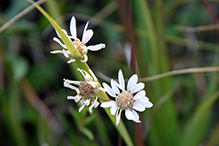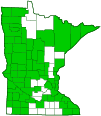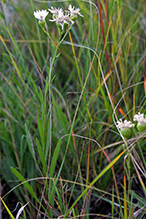prairie goldenrod
(Solidago ptarmicoides)
Conservation • Description • Habitat • Ecology • Use • Distribution • Taxonomy
Conservation Status |
|
|||||||
| IUCN Red List | not listed |
|||||||
| NatureServe | N5 - Secure SNR - Unranked |
|||||||
| Minnesota | not listed |
|||||||
Description |
||
Prairie goldenrod is a 4″ to 24″ tall, erect, perennial forb that rises on 1 to 20 or more stems from a thick, short, branched caudex. It looks much like an aster, little like a goldenrod. The stem is erect, slender, and round. It is light green, not shiny, often with dark green vertical lines. It is unbranched below the middle and often branched above the middle. Near the top it is moderately rough to the touch due to a sparse covering of stiff, upward curved hairs. It is hairless or nearly hairless near the base. One to several flowering stems rise from a rosette of basal leaves. Basal leaves are narrowly inversely egg-shaped to nearly linear, 2⅜″ to 4″ long, and ¼″ to ⅜″ wide. They are relatively thick, stiff, and stalkless or on short leaf stalks. They taper to the base and are angled to a sharp point at the tip. The upper and lower surfaces are hairless and smooth or sparsely hairy and slightly rough to the touch. There are usually 3 main veins visible on the underside. The margins are untoothed or have a few shallow, sharp, forward pointing teeth. There is often a second rosette of basal leaves adjacent to the flowering stem. Lower stem leaves are alternate and similar to basal leaves. Basal and lower stem leaves are present at flowering time. Middle and upper stem leaves are alternate, linear or very narrowly inversely lance-shaped, ¾″ to 1½″ long, and ⅛″ to 3 ⁄16″ wide. They are stalkless and untoothed, They have a single main vein and may have a faint pair of lateral veins. They are otherwise similar to lower stem leaves. The inflorescence is a branched, flat-topped or shallowly rounded, cluster (corymb) of flower heads at the end of the branches. The corymbs have short to long, ascending branches with 1 or a cluster of 2 or more uncrowded flower heads per branch. The flower heads are clustered at the end of the corymb branch. Each flower head is on a 1⅛″ to 1½″ long stalk. The flower heads are about ½″ in diameter. The whorl of smaller bracts subtending the flower head (involucre) is 3 ⁄16″ to ¼″ long. The bracts of the involucre are linear to lance-shaped, tightly appressed, and hairless. The flower heads have 10 to 25 usually white, sometimes pale cream-colored, ray florets and 30 to 36 usually white, sometimes pale cream-colored, disk florets. The ray florets are ¼″ to ⅜″ long. Each disk floret has 5 stamens with yellow anthers, which often causes the disk to appear yellow. The fruit is a ribbed achene with a tuft of white hairs at the tip. |
||
Height |
||
4″ to 24″ |
||
Flower Color |
||
White ray florets, white disk florets |
||
Similar Species |
||
The white disk florets distinguish this plant from asters. The large white ray florets distinguish it from other goldenrods. |
||
Habitat |
||
Dry. Prairies. Full sun. Sandy, limey soil, cracks in rocks. |
||
Ecology |
||
Flowering |
||
July to September |
||
Pests and Diseases |
||
|
||
Use |
||
|
||
Distribution |
||||
|
Sources |
|||
| 5/27/2023 | ||||
Nativity |
||||
Native |
||||
Occurrence |
||||
Common |
||||
Taxonomy |
|||
| Kingdom | Plantae (Plants) | ||
| Division | Tracheophyta (Vascular Plants) | ||
| Subdivision | Spermatophytina (Seed Plants) | ||
| Class | Magnoliopsida (Dicots) | ||
Order |
Asterales (Sunflowers, Bellflowers, Fanflowers, and Allies) | ||
Family |
Asteraceae (Sunflowers, Daisies, Asters, and Allies) | ||
| Subfamily | Asteroideae | ||
| Supertribe | Asterodae | ||
| Tribe | Astereae (asters and allies) | ||
| Subtribe | Solidagininae | ||
| Genus | Solidago (goldenrods) | ||
| Subgenus | Pleiactila | ||
| Section | Ptarmicoidei | ||
Prairie goldenrod was formerly classified as an aster and given the name Aster ptarmicoides. It was subsequently found to hybridize with Solidago species but not with Aster species, and is now classified as a goldenrod. Recent molecular research on the garden plant x Solidaster shows it to be a hybrid of this plant (prairie goldenrod) and Canada goldenrod (Solidago canadensis). Prairie goldenrod, therefore, is more accurately placed in the genus Solidago, as Solidago ptarmicoides. Some taxonomist separate the seven flat-topped goldenrod species in the Solidago section Ptarmicoidei as a separate genus Oligoneuron. The Global Compositae Database lists prairie goldenrod as Oligoneuron album, with Solidago ptarmicoides a synonym. The Global Compositae Checklist lists it as Solidago ptarmicoides, with Oligoneuron album a synonym. Almost all other sources list it as Solidago ptarmicoides. |
|||
Subordinate Taxa |
|||
|
|||
Synonyms |
|||
Aster ptarmicoides Aster ptarmicoides var. georgianus Doellingeria ptarmicoides Inula alba Oligoneuron album Solidago asteroides Unamia alba |
|||
Common Names |
|||
prairie goldenrod snowy aster upland white aster white flat-toped goldenrod white upland aster white upland goldenrod |
|||
Glossary
Achene
A dry, one-chambered, single-seeded seed capsule, formed from a single carpel, with the seed attached to the membranous outer layer (wall) only by the seed stalk; the wall, formed entirely from the wall of the superior ovary, does not split open at maturity, but relies on decay or predation to release the contents.
Bract
Modified leaf at the base of a flower stalk, flower cluster, or inflorescence.
Caudex
A short, thickened, woody, persistent enlargement of the stem, at or below ground level, used for water storage.
Corymb
A flat-topped or convex inflorescence in which the stalked flowers grow upward from various points on the main stem to approximately the same horizontal plane. The outer flowers open first.
Involucre
A whorl of bracts beneath or surrounding a flower, flower head, or flower cluster.
Linear
Long, straight, and narrow, with more or less parallel sides, like a blade of grass.

Slideshows |
||

Visitor Videos |
|||
Share your video of this plant. |
|||
| This button not working for you? Simply email us at info@MinnesotaSeasons.com. Attach a video, a YouTube link, or a cloud storage link. |
|||
Other Videos |
|||

Visitor Sightings |
|||||
Report a sighting of this plant. |
|||||
| This button not working for you? Simply email us at info@MinnesotaSeasons.com. Be sure to include a location. |
|||||
|
|||||
MinnesotaSeasons.com Sightings |
|||||
Badoura Jack Pine Woodland SNA Margherita Preserve-Audubon Prairie Northern Tallgrass Prairie NWR, Hoffman Unit Northern Tallgrass Prairie NWR, Pavia Unit Northern Tallgrass Prairie NWR, Spieker Unit Pankratz Memorial Prairie, North Unit Pembina Trail Preserve SNA, Crookston Prairie Unit |
|||||

|
Created: Last Updated: © MinnesotaSeasons.com. All rights reserved. |


